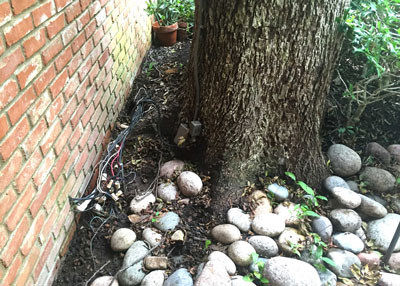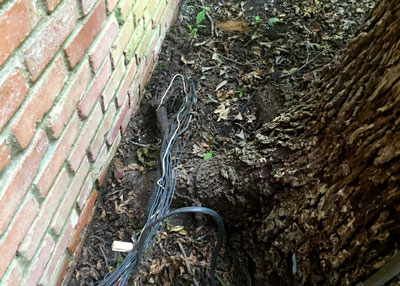From the Sperry Gardens: “Uh oh!”
It was such a great idea at the outset. Build our house where a small pecan tree could grow to shade it. That was back in 1977, and shade was at a premium here at the Sperry spot.

Massive pecan is the largest tree on our property. It’s also the closest one to our house. Therein lies the problem.
I was still working for the Extension Service. We lived in Farmers Branch, and the house was being built outside McKinney. The week the foundation was formed and poured, I was somewhere out in West Texas doing Extension work. When I returned, to my horror, the slab had been poured 18 inches closer to the tree’s trunk than we had expected, and 8 inches of topsoil had been scraped away from its roots. It was way too late to move either the tree or the foundation, so we’ve spent the ensuing 38 years trying to make the best of it.
I quickly shoveled the soil back up around the bare roots and watered the tree deeply. The next fall it had lost all of its leaves by this time (first of September), and I was doubting whether it would even make it. But the next year, it held its leaves until frost, and the third year it started to grow and grow and grow. What had been one of the smaller trees (8-inch diameter) in our 11-acre pecan forest has grown to become by far the largest. It’s now 34 inches in diameter, and it dwarfs our house.
So why the surgery? Because our front door was becoming stuck shut, and in clearing out around the base of the tree, I discovered what I thought was a 4-inch root going back beneath the foundation. It was obviously the culprit.
I did what any sane homeowner would do: I called Arborilogical Services of DFW, my longtime advertiser on radio, website and here in e-gardens. They sent out certified arborist and general manager Bryan White and air spade technologists Trevor and Garrett, and they proceeded to expose the entire root.

You can see the proximity of the pecan’s trunk and root system to our house’s foundation. Finally, after 38 years, a problem had started to develop.

The size of the root and the mass of sprinkler cables become obvious on closer inspection.

Bryan White is general manager of Arborilogical Services. He’s also the certified arborist who keeps an eye on the Sperry trees. After Trevor and Garrett had exposed the roots with an air spade (very impressive!), Bryan inspected the roots and proceeded to start the necessary cuts.
The short form of what happened was that the root had grown to 10 inches in diameter, not the 4 inches I had estimated. It hit the well-designed and very sturdy foundation, then grown into a mass of roots against the outer edge of the concrete. The guys cut through the root with a chain saw, then surgically removed the few pieces that remained with a very large, very sharp chisel.
The root has been severed, so it will do no more lifting. The foundation, designed by a commercial architect, is still sound. We decided that root probably represented no more than 5 or 10 percent of the root volume of such a large pecan, so the tree should be sound and secure with no great impact from a cut made this late in a moist season. And we agreed to have Arborilogical back for their regular visit to check on the tree’s vigor come springtime.
Thanks for the great work go to Arborilogical Services. Our trees are in good hands!
